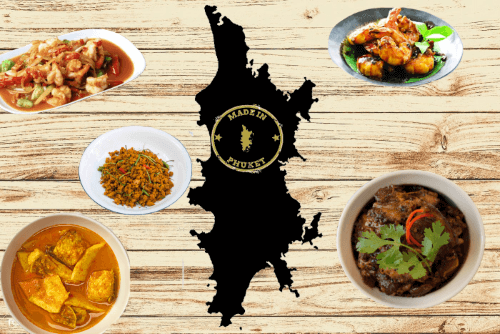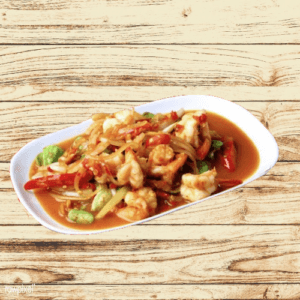Five classic Phuket dishes
Thai food is available in restaurants all over the world. But for the most authentic taste of Thailand, you really should come to visit the country and taste food cooked by locals using fresh local ingredients and served as it should be.
In this month’s article, we look at the top five authentic Southern Thai dishes you should savor during your time in Phuket. Maybe it will give some restaurants the opportunity to change a little from the ordinary for take away or delivery food or you might try make it yourself.
Sataw Pad Kapi Goong
Sataw, also known as stink beans, is a major ingredient in southern Thai cuisine due to the fact that they thrive in the region. The stink bean is crunchy, packed with amino acids, and smells like methane (but in a good way). It must be eaten to be believed – and absolutely must be tried fresh. In Sataw Pad Kapi Goong, stink beans are stir-fried with fresh prawns and shrimp paste. This dish is unique, flavorsome and combines spicy and sour flavors in a way that can’t be tasted anywhere else.
Ingredient
1 cup stink beans
1 tbsp. shrimp paste
1 cup sliced onion
6 – 8 each small garlic cloves
10 each de-veined medium size prawns
2 each red chee-fah chili, remove seeds and membrane
1 tbsp. fish sauce
2 tbsp. lime sauce
1 tbsp. sugar
2 tbsp. oil
How-to
- Pound the peppers and garlic in a mortar.
- Heat the oil in a pan over medium heat, add the peppers and garlic, stir-fry until aromatic. Add the shrimp paste, and stir-fry until mixed
- Add the onion and bitter beans, turn up the heat. Stir-fry until well cooked. Season with fish sauce, sugar and lime juice.
- Remove from the heat and serve.
Khua Kling Moo Saab
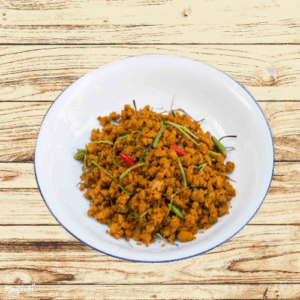 A Southern Thai classic. In this dish, the spicy dry curry is stir-fried with diced pork and loads of chili. Hot, spicy and authentically Thai, this is not a dish for the faint-hearted but, if you can handle the heat, you really should try this most famous Thai dish in its homeland.
A Southern Thai classic. In this dish, the spicy dry curry is stir-fried with diced pork and loads of chili. Hot, spicy and authentically Thai, this is not a dish for the faint-hearted but, if you can handle the heat, you really should try this most famous Thai dish in its homeland.
Ingredients
500 g. minced pork, beef, or chicken (I used minced meat, but small slices of meat are common too)
3 tbsp. southern Thai curry paste
50 g. lemongrass
1 red spur chili (this is not completely necessary, but if you add one, it will make your curry look really nice)
10 – 15 kaffir lime leaves (you can use about ¾ of them while cooking, and used the other ¼ to sprinkle on top at the end)
pinch of sugar (depending on how much you like and how much you want to)
Thai bird chilies (I like to slice up some red Thai bird chilies to sprinkle on top of my plate, just for the final spicy touch and for extra red color)
Instructions
The first step is to take your lemongrass, slice off the bottoms of the stalks, tear off two or three of the tough outer layers, and then finely shave it. The finer you shave the lemongrass, the more flavor it will add, and the the easier it will be to chew.
To prepare the kaffir lime leaves, you want to grab about five or six leaves, which come as a pair, then I like to fold them over, so you’ve got a nice layered sandwich of kaffir lime leaves. Slice off any of the big stems if there are any, and then finely slice them into thin strips.
I included the spur chili in this recipe mostly to give the khua kling a beautiful red accent color, but it’s not what gives the dish its spice – that comes from the curry paste. For the spur chili, just cut off the stem, slice the chili in half, and then slice it into thin diagonal strips. Set all those ingredients aside, and we’ll come back to them later.
Turn on your stove to a medium high heat, heat up your wok or pan for a few seconds, and then add about 3 tbsp. of southern Thai curry paste (it may be kind of dry, but since this is a dry curry, you don’t want to add any oil).
One of the tricks my wife taught me, so the curry paste doesn’t burn, is to quickly add in just 1 spoon of meat into the curry paste and start to stir fry it. This will give the curry paste a little extra moisture, but it will still get that direct heat that you want, so the curry paste reaches its maximum flavor potential.
Fry the curry paste for 2 – 3 minutes, and then add in the rest of the meat. Your pan should be quite hot, and due to the dryness, it might start to stick to the bottom. So you want to really work the wok hard by scraping and getting all that good flavor off the bottom of the pan.
Stir fry the meat until it’s broken into small minced pieces, and almost all the way cooked through, then toss in just a pinch of sugar, depending on how much you like (I used about ½ teaspoon, but I know some Thai cooks would use a whole spoon in their recipe).
Give it a quick stir, then add the lemongrass.
Quickly stir it, then toss in about ¾ of your shaved kaffir lime leaves. Stir fry for about 1 minute.
Just a few seconds before turning off your heat, add the sliced red spur chili, stir fry for a few more seconds, and turn off your heat, but keep frying for another minute or so.
Grab a bowl, and dish out your khua kling.
The final step is to take the remaining portion of your finely shaved kaffir lime leaves (of you can slice more if you used them all), along with a handful of sliced Thai bird chilies, and sprinkle them on top of your plate of khua kling.
Gaeng Leung Yod Maprao Pla
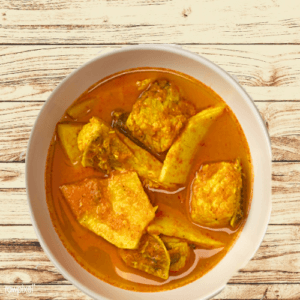 A dish packed with spice and flavor. Many Thai restaurants in western countries focus only on red and green curries but this is made using a thick yellow gravy which is often livened up with tender coconut shoots to counteract the spice and huge chunks of freshly caught fish which soak up all that lovely flavor.
A dish packed with spice and flavor. Many Thai restaurants in western countries focus only on red and green curries but this is made using a thick yellow gravy which is often livened up with tender coconut shoots to counteract the spice and huge chunks of freshly caught fish which soak up all that lovely flavor.
Ingredient
500 grams sea bass, cut into bite-size pieces
2 cups Koon stalk (Giant Elephant Ear), tender portion, cut into 1 inch pieces
2 tbsp. palm sugar
¼ cup tamarind juice
3 tbsp. fish sauce
1 tbsp. lime juice
Ingredients for Sour Curry Paste
20 each bird eye chilies
1 each turmeric, cut into 2-inch pieces
4 each red shallots
15 each garlic cloves
2 tsp. shrimp paste
A pinch of salt
How-to
- Pound together the bird eye chilies and salt. Add the rest of the spices, and keep pounding until thoroughly mixed. Add the shrimp paste and pound until well mixed.
- Boil water in a pot and add the sour curry paste. Add the Koon, making sure they are well-cooked. Add the sea bass. Wait for the liquid to a boil again.
- Season with the palm sugar, fish sauce, tamarind juice and lime juice.
- Remove from the heat.
Moo Hong
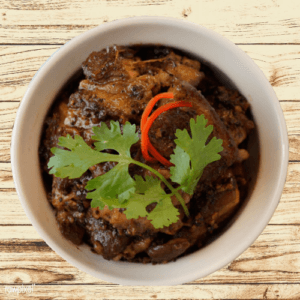 Also known as Phuket pork belly stew, tender stewed pork is smothered in a classic southern Thai-style sweet sauce. Chunks of pork belly are braised in a paste of garlic, black peppercorns, and coconut sugar. Similar to the Chinese dish, Moo Palo, but with fewer ingredients, this is simple to make and demonstrates why, if you prepare and cook food properly, it doesn’t need to be overly complicated.
Also known as Phuket pork belly stew, tender stewed pork is smothered in a classic southern Thai-style sweet sauce. Chunks of pork belly are braised in a paste of garlic, black peppercorns, and coconut sugar. Similar to the Chinese dish, Moo Palo, but with fewer ingredients, this is simple to make and demonstrates why, if you prepare and cook food properly, it doesn’t need to be overly complicated.
Ingredients
400 g of pork belly
400 g of lean pork shoulder
0.80 bulb of garlic about 8-10 cloves peeled
0.80 bunch of fresh coriander
2.40 fresh Coriander roots or 5-6 stems roughly chopped
0.80 tablespoon of whole black peppercorns or half white, half black
0.80 tablespoon of coconut palm sugar or normal palm sugar if you can’t find it
2.40 whole star anise
0.80 whole cinnamon stck
1.60 tablespoon of light soy sauce
1.60 tablespoon of oyster sauce
1.60 tablespoon of dark sweet soy sauce use kecap manis if you can’t find it
rice bran oil for frying
Instructions
Cut the pork belly and shoulder into equal sized chunks and set aside.
Pound the garlic, coriander stalks and pepercorns in a pestle and mortar to a fine paste.
Fry the pork in batches in a little oil over a medium/high heat until browned all over, leaving any residual fat in the pan.
Add a little more oil if necessary and fry the paste for a couple of minutes over a medium heat, taking care not to let it catch on the bottom of the pan.
Chuck the pork back in and stir to coat. Add the cinnamon stick, the star anise, all the sauces and the palm sugar. Keep stirring until everything is well combined and the sugar has dissolved.
Pour in enough water to just cover the pork and bring to the boil. Immediately lower to a simmer and cook for two hours or until the pork is tender, adding more water if the pork looks like it’s getting too dry.
Serve in bowls topped with a bunch of fresh coriander, next to steamed Jasmine rice.
Goong Pad Makham
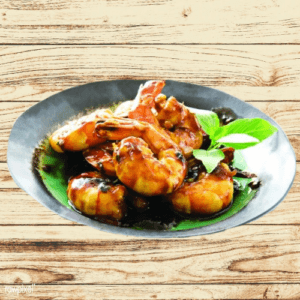 Another great Southern Thai classic is this one, made from normal Thai store cupboard ingredients such as palm sugar, fish sauce, and tamarind paste. This is a dish that often appears on local dining tables. Fried prawns and succulent meat combine with sauces for a strong combination of sweet, salty and sour flavors.
Another great Southern Thai classic is this one, made from normal Thai store cupboard ingredients such as palm sugar, fish sauce, and tamarind paste. This is a dish that often appears on local dining tables. Fried prawns and succulent meat combine with sauces for a strong combination of sweet, salty and sour flavors.
Ingredients
2 shallots (roughly chopped)
3 cloves garlic
5-6 coriander stems
2 Thai chilies
250g large shrimp (de-veined and shells removed)
½ cup chicken stock
3 Tbsp grated palm sugar
1.5 Tbsp fish sauce
3 Tbsp tamarind juice
¼ cup red and green capsicum (julienned)
Fried shallots (for garnish)
Fried dried chillis (for garnish)
Coriander leaves (for garnish)
Preparation: Using a food processor, process the garlic, shallots, coriander stems, and Thai chillis into a rough paste or you can use a Mortar.
How to Cook
In a wok, heat some vegetable oil over medium high heat. When the oil begins to smoke, sear the shrimp on all sides until brown. Remove the shrimp from the wok and set aside.
Using fresh vegetable oil, sauté the herb paste over medium heat until fragrant and slightly brown.
Then add chicken stock, palm sugar, tamarind juice, and fish sauce. Increase the heat up to medium high and stir constantly, until the sugar is dissolved. Cook the sauce and reduce it until it becomes a thick sauce that can coat the back of your spatula.
Toss in the shrimp and red and green capsicum to mix with the sauce. Finish cooking the shrimp if they are not already done.
Transfer to a serving plate and garnish generously with fried shallots, fried dried chillis and coriander leaves. Serve with a bowl of hot white rice.
Once you’ve been to Phuket, it’s hard to stay away. And once you’ve tasted authentic, locally-sourced Southern Thai cuisine, you’ll never look at Thai food in quite the same way. Food is a huge part of Thai culture and at Funfood Thailand, we want to help you experience the complete culture of this beautiful part of the world
Follow our newsletter and next time we’ll tell you about other delicious regional foods or specialties in Thailand.








